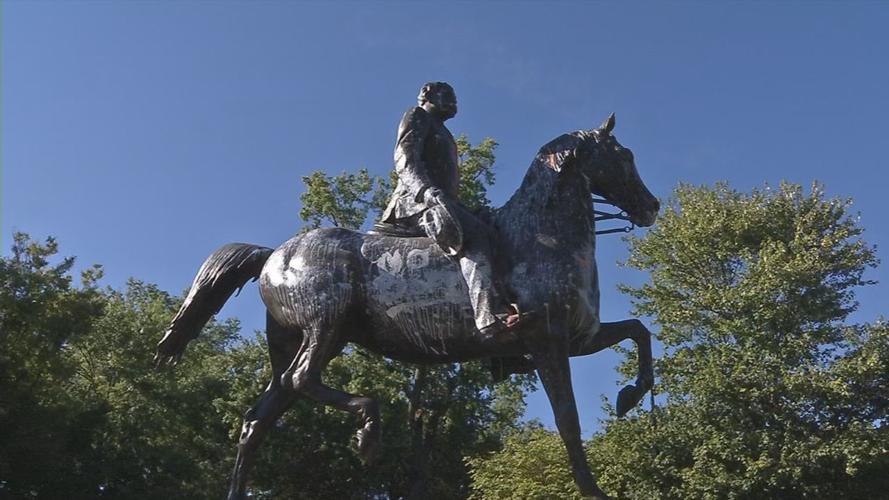LOUISVILLE, Ky. (WDRB) – A Louisville judge has ruled that the city does not have to reinstall the controversial John B. Castleman statue to its long-time location, finding that the mayor "can remove the statute at will."
An attorney representing a group called Friends of Louisville Public Art had asked a judge to order the city to restore the statue after the state Supreme Court ruled that lower courts erred when they agreed the city properly removed the statue from its site near Cherokee Park in 2020.
Attorney Steve Porter successfully argued to the high court that two commissioners on the Historic Landmarks Commission, which voted to remove the statue, had a conflict of interest as they were hired by former Mayor Greg Fischer, who wanted the statue removed.
But in a ruling Monday, Jefferson Circuit Judge Jennifer Wilcox said that under the law, Metro Government simply has to ask the Landmarks Commission for a "mandatory review," but does not have to comply with its decision.
The city provided notice to the commission on June 20 that the statue would be permanently removed, according to the ruling.
While the commission has 60 days to review the notice, "reinstalling the statue would be futile even in the interim of waiting for the Landmarks Commission's approval or denial of the proposal because Metro Government is not required to comply with the Landmark Commission's recommendation," Wilcox ruled.
The Supreme Court was not asked about and did not review the issue of whether the city could remove the statue regardless of how the commission ruled.
In a statement, Porter said his clients are "extremely disappointed" in the decision and will deliberate on whether to appeal.
He said the more "immediate problem" is that the city is attempting, in three public meetings this week, to "get approvals for preventing the statue from being reinstalled."
"This uninformed and hypocritical rush is unbelievable and unacceptable," Porter said in the statement. "The only reason stated so far has been that the statue is not 'welcoming.' There are seven other public statues in Metro of persons who were major slaveholders during their lifetimes, including even Mother Catherine Spalding, most of whom never regretted their ownerships. Are they “welcoming” to all?"
Castleman never owned a slave, Porter said, and "spent the last 52 years of his life in service to our community and preventing discrimination against African-Americans. His statue is not a Confederate statue. Even one of our more modern statues honors a man who refused to admit African-Americans to his hotel until forced by public accommodations laws. Is his statue welcoming to all?"
He said he had tried to talk with Mayor Craig Greenberg but has not gotten a response.
Kevin Trager, a spokesman for the mayor, said in a statement that "we are pleased with this decision. As we stated previously we have no desire or plans to put the statue back in its previous location. We look forward to resolving this matter as soon as possible.”
The thrust of the case before the high court was not whether the statue of Castleman — a depiction of him riding a horse, dressed in civilian clothes — served as a symbol of "racist or bigoted ideology," as Fischer has said, but whether the city followed due process in removing it.
The high court agreed in a 6-1 vote that “the decision-making participation in this matter by Louisville Metro employees is an inherent and intolerable conflict of interest.
"... Their employment and their being asked to sit in review of an application filed by their employer were sufficient to raise a reasonable question of impartiality such that recusal was required as a matter of law," Chief Justice Laurence B. Vanmeter wrote for the majority.
In addition, the high court noted that the Landmarks Commission did not issue a findings of fact to remove the statue.
The monument in the Highlands was the center of controversy for years because its critics argue that Castleman is closely associated with the Confederacy and white supremacy. The statue, which was erected in 1913, was vandalized numerous times.
The statue currently sits in a gated government lot, covered in bright orange spray paint.
The group fighting to save the statue has argued that Castleman redeemed himself later in his life, renouncing the Confederate cause, calling on white soldiers to salute Black officers in World War I and helping to establish Louisville’s park system.
The high court agreed in June of last year to hear arguments after the state Court of Appeals upheld a Jefferson Circuit Court judge’s ruling dismissing the lawsuit.
The appeals court ruled, in part, there were "no facts to support the conflict of interest claim."
Fischer announced the removal of the Castleman and George Prentice statues in 2018, saying they served as racist symbols. The Prentice statue was removed from its spot in front of the downtown library in December 2018.
On May 9, 2019, Louisville's Landmark Commission voted to remove the Castleman statue.
The Landmark Commission's vote followed a January 2019 vote by the Cherokee Triangle Review Commission that ended in a tie, meaning the statue could not be removed.
That's when the city appealed to the Landmarks Commission, which gave the green light for the statue's removal.
This story may be updated.
Copyright 2023 WDRB Media. All Rights Reserved.














